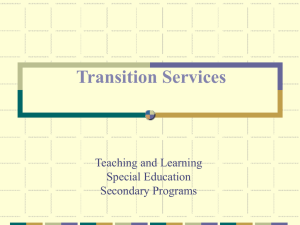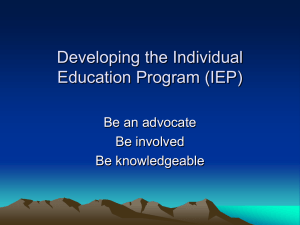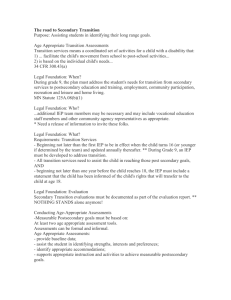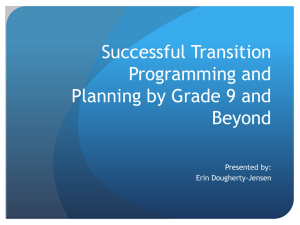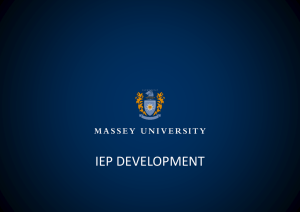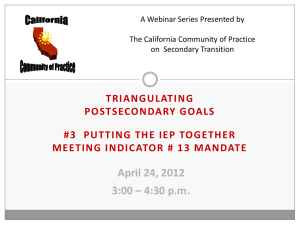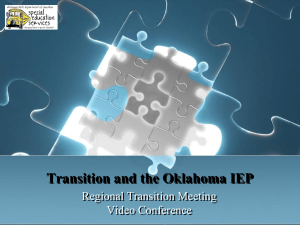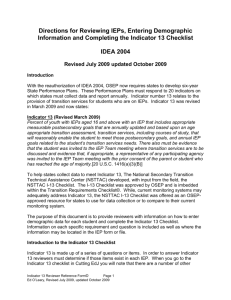Webinar – Transition Presentation
advertisement
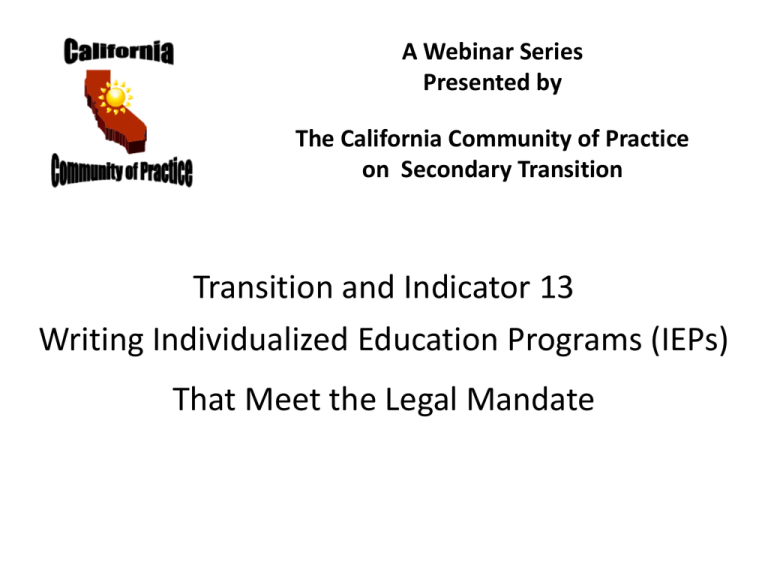
A Webinar Series Presented by The California Community of Practice on Secondary Transition Transition and Indicator 13 Writing Individualized Education Programs (IEPs) That Meet the Legal Mandate Welcome J i l l L a r s o n , F a c i l i t a t o r, C o m m u n i t y o f P r a c t i c e California Department of Education Presenters S u e S a w ye r, C a l i f o r n i a Tr a n s i t i o n A l l i a n c e Vi c k i S h a d d , G l e n n C o u n t y O f f i c e o f Education Quiz True or False? Students are required to be present at the IEP meeting. Schools must require agencies to attend the IEP meeting. Indicator 13 indicates the student’s plans. Today’s Goals Define the mandates for secondary transition. Align mandates with research-based best practices. Map the IEP. Individuals with Disabilities Education Act (IDEA) Secondary Transition Focus: Improve academic and functional achievement to facilitate movement from school to post-school activities Based on youth’s strengths and interests Includes instruction, related services, community experience, development of employment, and other postschool living objectives Mandates the development of a plan that summarizes skills, strengths, transition readiness, needs Transition: Best Practices References National Collaborative on Workforce and Disability–Youth www.ncwd-youth.info National Secondary Transition Technical Assistance Center www.nsttac.org Transition Coalition www.transitioncoalition.org National Office of Special Education programs www.osep.gov California Department of Education www.cde.ca.gov/specialeducation National Statistics Tell Us Effective Transition Planning is Critical for Youth with Disabilities 29 percent of working age adults with disabilities reported employment vs. 70 percent of people without disabilities. 25 percent of people with disabilities live in poverty with average annual incomes at less than $15,000. 26 percent of workers with Intellectual Disabilities/Developmental Disabilities (ID/DD) are working in community employment, with the majority still in sheltered and non-work settings. 26 percent of high schools offer work-based experiences vs. 74 percent classroom based learning. The Good News People who are competitively employed are contributing to the economy. Employment training and vocational experiences lead to better post-school outcomes. Improvements occur in academic performance, school attendance, social development and increased problemsolving ability, enhanced “soft skills,” job readiness, and knowledge of entrepreneurial skills. Transition Services as Defined in IDEA Focus: Improve academic and functional achievement to facilitate movement from school to post-school activities (postsecondary education, vocational education, integrated employment, continuing and adult education, adult services, independent living or community participation.) Based on youth’s strengths, preferences, and interests. Includes instruction, related services, community experience, development of employment, and other post-school living objectives. Mandates the development of a plan that summarizes skills, strengths, transition readiness, needs. California State Performance Plan Indicators related to transition: 1. Increase graduation rate 2. Decrease drop-out rate 13. Achieve compliance with federal guidelines on IEP 14. Improve outcomes: Employment Postsecondary education / training Independent living Indicator 13: Measurable Postsecondary Goals 1. Are there appropriate measurable postsecondary goals in the area of education and training, employment and, as needed, independent living? Statements of what the student will achieve after leaving high school. Must be stated in measurable terms. Indicator 13: Measurable Postsecondary Goals The IEP is based on the student’s goals. Indicator 13: Annual Update 2. Are the postsecondary goals updated annually? Student goals change as they gain experience, research their options and participate in work-based learning or career technical education. Indicator 13: Age Appropriate Assessment 3. Is there evidence that the measurable goal(s) were based on age-appropriate transition assessment? Transition assessments include career/vocational assessments and an evaluation of other transition issues (readiness for transition, life skills, resources and eligibility for support services). Indicator 13: Age Appropriate Assessment Indicator 13: Age Appropriate Assessment Indicator 13: List Transition Services 4. Are there transition services in the IEP that will reasonably enable the student to meet his/her postsecondary goal(s)? Transition Services listed in IDEA Regulations, and California Education Code with California Special Education Management Information System (CASEMIS) Codes: 820 – College Awareness 830 – Vocational Assessment, Guidance, Career Assessment 840 – Career Awareness, Self Advocacy, Career Planning 850 – Job Coaching 860 – Mentoring, sustained coaching 865 – Agency Linkages 870 – Travel/Mobility 890—Other coordination, Linkage 900- Other special education, Related Services Indicator 13: Course of Study 5. Do transition services include courses of study that will reasonably enable the student to meet his or her postsecondary goal(s)? The course of study defines the multi-year set of classes in the pathway to secondary goals (graduation, diploma, certificate). The course of study should also address career goals. The school transcript suffices for meeting this expectation only if it includes the multi-year course of study. If it only lists current and past courses, grades and credits, it is insufficient for meeting this requirement. Indicator 13: Annual goals 6. Is (are) there annual IEP goals related to the student’s transition service needs? The IEP has two types of goal statements: Postsecondary Goals Measurable Annual goals Measurable goals of what the student will achieve after leaving high school What the student will work on this year to help build the student’s skills in achieving the postsecondary outcomes Post = After Secondary = High school Annual = Each year May be a statement in the transition plan of the IEP or in the academic goals section. Indicator 13: Student Participation in IEP 7. Is there evidence that the student was invited to the IEP team meeting where transition services were discussed? The public agency shall invite the child with a disability to attend his or her IEP meeting if a purpose of the meeting will be the consideration of the postsecondary goals for the child and the transition services needed to assist the child in reaching those goals. 34 Code of Federal Regulations (CFR) §300.37(b)(1) If the child does not attend the IEP Team meeting the public agency must take other steps to ensure that the child’s preferences and interests are considered. 34 CFR §300.321(b)(2) Indicator 13: Student Participation in the IEP There are five levels of participation in the IEP (Source: Transition Coalition): Student input provided indirectly based on a questionnaire or survey. Passive observer (in the room, avoids the conversation). Reluctant participant (responds to direct questions). Self-advocate (practices self-advocacy skills). Leader (demonstrates leadership skills in the IEP). Indicator 13: Agency Participation 8. If appropriate, is there evidence that a representative of any participating agency was invited to the IEP with prior consent of the parent or student who has achieved the age of majority? List N/A if the agency did not participate because of the student’s age or grade.
